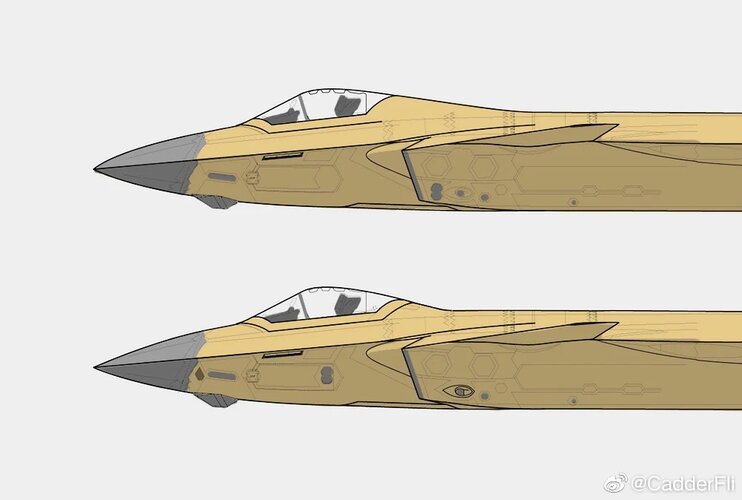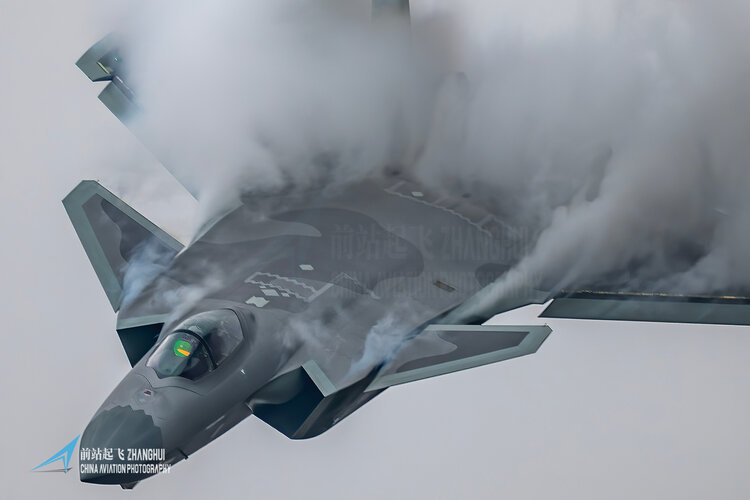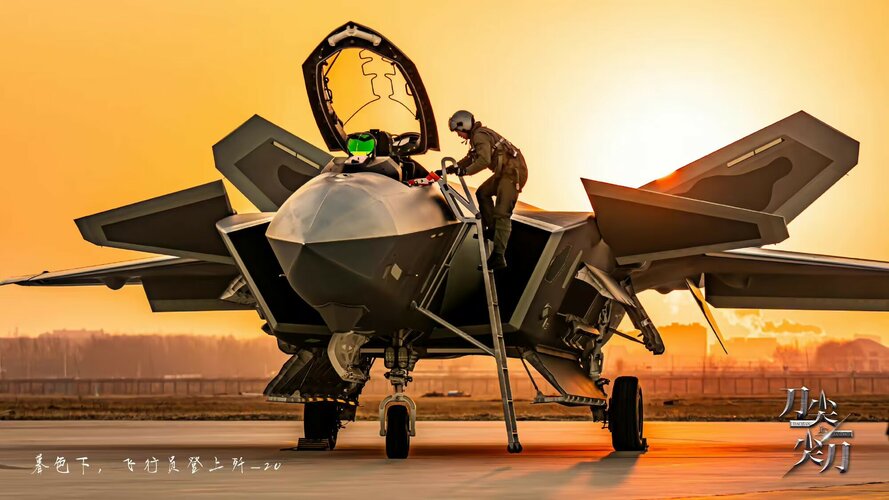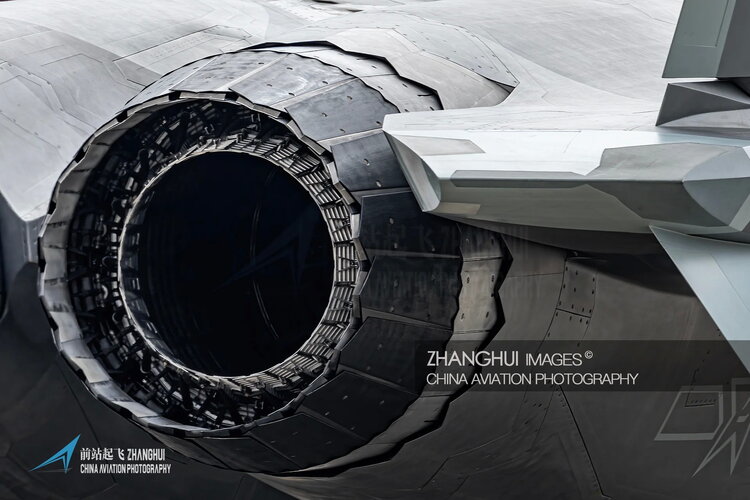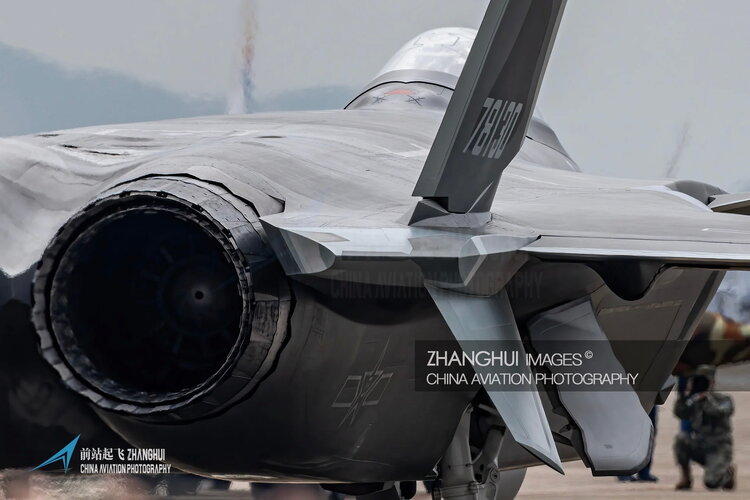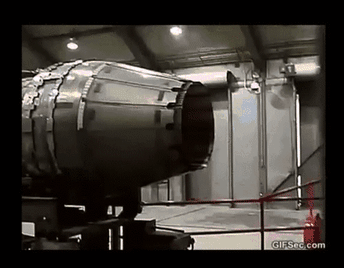You are using an out of date browser. It may not display this or other websites correctly.
You should upgrade or use an alternative browser.
You should upgrade or use an alternative browser.
Chengdu J-20 news and analysis Part III
- Thread starter overscan (PaulMM)
- Start date
- Joined
- 2 August 2006
- Messages
- 3,253
- Reaction score
- 1,518
The main reason for the canopy redesign is lower drag at higher speeds. Just like it is on the F-22.
As for T/W, all that really is is a measure of the engines overall efficiency. All things being equal an engine with a T/W ratio of 10 vs 8, means it is producing more thrust for less weight, which means it's a more efficient design. As a result, it means an airplane designed for a specific mission, will have higher performance with the engine that has T/W of 10 versus one that has a T/W of 8, as it will weigh less for the same thrust. Lower weight, generally, leads to higher performance; both kinetic and in terms of efficiency. As for supercruise, etc., you really need to know things like the TIT, Bypass Ratio, etc. T/W in and of itself isn't an indicator of any specific performance design point.
As for T/W, all that really is is a measure of the engines overall efficiency. All things being equal an engine with a T/W ratio of 10 vs 8, means it is producing more thrust for less weight, which means it's a more efficient design. As a result, it means an airplane designed for a specific mission, will have higher performance with the engine that has T/W of 10 versus one that has a T/W of 8, as it will weigh less for the same thrust. Lower weight, generally, leads to higher performance; both kinetic and in terms of efficiency. As for supercruise, etc., you really need to know things like the TIT, Bypass Ratio, etc. T/W in and of itself isn't an indicator of any specific performance design point.
- Joined
- 15 January 2021
- Messages
- 392
- Reaction score
- 1,428
I can’t disagree with your premise. However, I was pointing out a very high T/W design may incompatible with supercruise performance and vis versa. Trying to accomplish both simultaneously may be a bridge to far, resulting in the protracted and so far unsuccessful development of the IZD30 and WS-15.The main reason for the canopy redesign is lower drag at higher speeds. Just like it is on the F-22.
As for T/W, all that really is is a measure of the engines overall efficiency. All things being equal an engine with a T/W ratio of 10 vs 8, means it is producing more thrust for less weight, which means it's a more efficient design. As a result, it means an airplane designed for a specific mission, will have higher performance with the engine that has T/W of 10 versus one that has a T/W of 8, as it will weigh less for the same thrust. Lower weight, generally, leads to higher performance; both kinetic and in terms of efficiency. As for supercruise, etc., you really need to know things like the TIT, Bypass Ratio, etc. T/W in and of itself isn't an indicator of any specific performance design point.
djfawcett
With Enough Power, Anything Will Fly
- Joined
- 16 December 2012
- Messages
- 268
- Reaction score
- 388
It is a pretty good bet that they are cleaning up the shock that would form right on top of the canopy (had to clean something like that in the past). See pic Although, it seems pretty late in the game to make such a change. I wouldn't be surprised they had a revelation when doing the tandem configuration.I saw this reply to @RupprechtDeino on Twitter
View: https://twitter.com/palpatine233/status/1606507887664459776
When translated, it means
"Although the frictional resistance is increased, the shock wave resistance is reduced and the space inside the machine is increased"
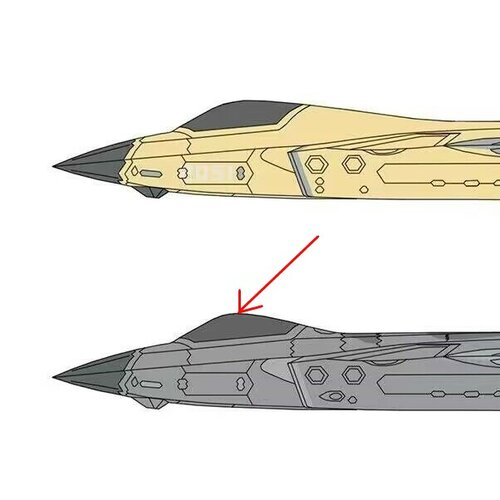
It is a pretty good bet that they are cleaning up the shock that would form right on top of the canopy (had to clean something like that in the past). See pic Although, it seems pretty late in the game to make such a change. I wouldn't be surprised they had a revelation when doing the tandem configuration.I saw this reply to @RupprechtDeino on Twitter
View: https://twitter.com/palpatine233/status/1606507887664459776
When translated, it means
"Although the frictional resistance is increased, the shock wave resistance is reduced and the space inside the machine is increased"
View attachment 690056
More like they were developing a new variant to succeed the existing single seat J-20A in production anyway, and among other changes (including being intended to make use of WS-15 in the future) were thus considered as being worthwhile.
The revised dorsal fuselage/canopy geometry and the slight reduction in rear sector visibility is an acknowledgement over the last decade's air warfare trends that sacrificing a bit of rear sector visibility for other things is a worthwhile trade.
- Joined
- 2 August 2006
- Messages
- 3,253
- Reaction score
- 1,518
I can’t disagree with your premise. However, I was pointing out a very high T/W design may incompatible with supercruise performance and vis versa. Trying to accomplish both simultaneously may be a bridge to far, resulting in the protracted and so far unsuccessful development of the IZD30 and WS-15.The main reason for the canopy redesign is lower drag at higher speeds. Just like it is on the F-22.
As for T/W, all that really is is a measure of the engines overall efficiency. All things being equal an engine with a T/W ratio of 10 vs 8, means it is producing more thrust for less weight, which means it's a more efficient design. As a result, it means an airplane designed for a specific mission, will have higher performance with the engine that has T/W of 10 versus one that has a T/W of 8, as it will weigh less for the same thrust. Lower weight, generally, leads to higher performance; both kinetic and in terms of efficiency. As for supercruise, etc., you really need to know things like the TIT, Bypass Ratio, etc. T/W in and of itself isn't an indicator of any specific performance design point.
Indeed. I wasn't disagreeing with anyone. I was just trying to point out what the T/W ratio truly represents from a design perspective is all.
latenlazy
I really should change my personal text
- Joined
- 4 July 2011
- Messages
- 245
- Reaction score
- 37
The revelation came with the naval J-35 development actually. SAC probably figured this out when trying to optimize the J-35 for supercruise since they probably have tighter design headroom for that capability, and then CAC applied it to the J-20 to see if they could also get improvements.It is a pretty good bet that they are cleaning up the shock that would form right on top of the canopy (had to clean something like that in the past). See pic Although, it seems pretty late in the game to make such a change. I wouldn't be surprised they had a revelation when doing the tandem configuration.I saw this reply to @RupprechtDeino on Twitter
View: https://twitter.com/palpatine233/status/1606507887664459776
When translated, it means
"Although the frictional resistance is increased, the shock wave resistance is reduced and the space inside the machine is increased"
View attachment 690056
djfawcett
With Enough Power, Anything Will Fly
- Joined
- 16 December 2012
- Messages
- 268
- Reaction score
- 388
You actually know ......... or are you guessing. What you are guessing, if you are, make no sense. I know both the SAC and CAC organizations and they do not interact as you suggest.The revelation came with the naval J-35 development actually. SAC probably figured this out when trying to optimize the J-35 for supercruise since they probably have tighter design headroom for that capability, and then CAC applied it to the J-20 to see if they could also get improvements.It is a pretty good bet that they are cleaning up the shock that would form right on top of the canopy (had to clean something like that in the past). See pic Although, it seems pretty late in the game to make such a change. I wouldn't be surprised they had a revelation when doing the tandem configuration.I saw this reply to @RupprechtDeino on Twitter
View: https://twitter.com/palpatine233/status/1606507887664459776
When translated, it means
"Although the frictional resistance is increased, the shock wave resistance is reduced and the space inside the machine is increased"
View attachment 690056
latenlazy
I really should change my personal text
- Joined
- 4 July 2011
- Messages
- 245
- Reaction score
- 37
Just guessing. If you know better why don’t enlighten usYou actually know ......... or are you guessing. What you are guessing, if you are, make no sense. I know both the SAC and CAC organizations and they do not interact as you suggest.The revelation came with the naval J-35 development actually. SAC probably figured this out when trying to optimize the J-35 for supercruise since they probably have tighter design headroom for that capability, and then CAC applied it to the J-20 to see if they could also get improvements.It is a pretty good bet that they are cleaning up the shock that would form right on top of the canopy (had to clean something like that in the past). See pic Although, it seems pretty late in the game to make such a change. I wouldn't be surprised they had a revelation when doing the tandem configuration.I saw this reply to @RupprechtDeino on Twitter
View: https://twitter.com/palpatine233/status/1606507887664459776
When translated, it means
"Although the frictional resistance is increased, the shock wave resistance is reduced and the space inside the machine is increased"
View attachment 690056
Actually, I already did. Read the earlier postsJust guessing. If you know better why don’t enlighten us
.
I don't think your previous posts are anymore enlightening or more credible than what latenlazy wrote.
It's reasonable to say that right now we technically do not know why the dorsal fuselage and canopy has been revised, simply because we don't have an equivalent paper specifically studying J-20A->J-20B in the way that we did for FC-31->J-XY/35 its specific modification in this domain.
As it stands, I think it would be reasonable to make an educated guess that the purpose of the dorsal fuselage hump/canopy geometry modification serves a similar purpose to J-XY/35...
... but we don't have any info to suggest either way if they came to this modification through developing the twin seat J-20AS, or if they came to it through their own aerodynamic testing for a dedicated single seater new variant, or if it was through sharing of information between SAC and CAC through the overall AVIC parent organization.
djfawcett
With Enough Power, Anything Will Fly
- Joined
- 16 December 2012
- Messages
- 268
- Reaction score
- 388
This discussion has become a bit silly. To start, Latenlazy made a statement as if it was fact, which was not the case (that was the only point I was making - when he said actually, his premise became a bit misleading) . Enough said on that subject. The bottom line is that the aft canopy modification was most probably an effort to mitigate the canopy shock (both J-35 and J-20), which in fact will or can create a noticeable drag count rise. How they discovered it is irrelevant (quite frankly a simple CFD analysis will pick it up). As far as, AVIC acting as a conduit the transfer of data between SAC and CAC, it just does not happen that way. I have worked with AVIC and SAC prior to all the craziness in the world, and the sublevels of the AVIC organization or very compartmentalized. I suppose that it is possible that the information may transfer that way, but it is not very probable. What I have seen in the Chinese organizations is an attitude of "good is good enough". They probably knew that had a drag rise there but it was good enough. Furthermore, historically, it is somewhat common for Chinese aerospace firms to make late program modifications, and this is one of them.Actually, I already did. Read the earlier postsJust guessing. If you know better why don’t enlighten us
.
I don't think your previous posts are anymore enlightening or more credible than what latenlazy wrote.
It's reasonable to say that right now we technically do not know why the dorsal fuselage and canopy has been revised, simply because we don't have an equivalent paper specifically studying J-20A->J-20B in the way that we did for FC-31->J-XY/35 its specific modification in this domain.
As it stands, I think it would be reasonable to make an educated guess that the purpose of the dorsal fuselage hump/canopy geometry modification serves a similar purpose to J-XY/35...
... but we don't have any info to suggest either way if they came to this modification through developing the twin seat J-20AS, or if they came to it through their own aerodynamic testing for a dedicated single seater new variant, or if it was through sharing of information between SAC and CAC through the overall AVIC parent organization.
I do wish all a Merry Christmas!
latenlazy
I really should change my personal text
- Joined
- 4 July 2011
- Messages
- 245
- Reaction score
- 37
I said “probably”. What part of that suggests I’m making statements of fact?This discussion has become a bit silly. To start, Latenlazy made a statement as if it was fact, which was not the case (that was the only point I was making - when he said actually, his premise became a bit misleading) . Enough said on that subject. The bottom line is that the aft canopy modification was most probably an effort to mitigate the canopy shock (both J-35 and J-20), which in fact will or can create a noticeable drag count rise. How they discovered it is irrelevant (quite frankly a simple CFD analysis will pick it up). As far as, AVIC acting as a conduit the transfer of data between SAC and CAC, it just does not happen that way. I have worked with AVIC and SAC prior to all the craziness in the world, and the sublevels of the AVIC organization or very compartmentalized. I suppose that it is possible that the information may transfer that way, but it is not very probable. What I have seen in the Chinese organizations is an attitude of "good is good enough". They probably knew that had a drag rise there but it was good enough. Furthermore, historically, it is somewhat common for Chinese aerospace firms to make late program modifications, and this is one of them.Actually, I already did. Read the earlier postsJust guessing. If you know better why don’t enlighten us
.
I don't think your previous posts are anymore enlightening or more credible than what latenlazy wrote.
It's reasonable to say that right now we technically do not know why the dorsal fuselage and canopy has been revised, simply because we don't have an equivalent paper specifically studying J-20A->J-20B in the way that we did for FC-31->J-XY/35 its specific modification in this domain.
As it stands, I think it would be reasonable to make an educated guess that the purpose of the dorsal fuselage hump/canopy geometry modification serves a similar purpose to J-XY/35...
... but we don't have any info to suggest either way if they came to this modification through developing the twin seat J-20AS, or if they came to it through their own aerodynamic testing for a dedicated single seater new variant, or if it was through sharing of information between SAC and CAC through the overall AVIC parent organization.
I do wish all a Merry Christmas!
As for information in AVIC being compartmentalized…the information on the J-XY’s canopy change was published in a paper. That’s going to be pretty accessible…
djfawcett
With Enough Power, Anything Will Fly
- Joined
- 16 December 2012
- Messages
- 268
- Reaction score
- 388
Really, re-read what you wrote - no need here it is "The revelation came with the naval J-35 development actually. " Probably is not spelled "actually." I am done with this discussion. Again, Merry Christmassaid “probably”. What part of that suggests I’m making statements of fact?
This discussion has become a bit silly. To start, Latenlazy made a statement as if it was fact, which was not the case (that was the only point I was making - when he said actually, his premise became a bit misleading) . Enough said on that subject. The bottom line is that the aft canopy modification was most probably an effort to mitigate the canopy shock (both J-35 and J-20), which in fact will or can create a noticeable drag count rise. How they discovered it is irrelevant (quite frankly a simple CFD analysis will pick it up). As far as, AVIC acting as a conduit the transfer of data between SAC and CAC, it just does not happen that way. I have worked with AVIC and SAC prior to all the craziness in the world, and the sublevels of the AVIC organization or very compartmentalized. I suppose that it is possible that the information may transfer that way, but it is not very probable. What I have seen in the Chinese organizations is an attitude of "good is good enough". They probably knew that had a drag rise there but it was good enough. Furthermore, historically, it is somewhat common for Chinese aerospace firms to make late program modifications, and this is one of them.Actually, I already did. Read the earlier postsJust guessing. If you know better why don’t enlighten us
.
I don't think your previous posts are anymore enlightening or more credible than what latenlazy wrote.
It's reasonable to say that right now we technically do not know why the dorsal fuselage and canopy has been revised, simply because we don't have an equivalent paper specifically studying J-20A->J-20B in the way that we did for FC-31->J-XY/35 its specific modification in this domain.
As it stands, I think it would be reasonable to make an educated guess that the purpose of the dorsal fuselage hump/canopy geometry modification serves a similar purpose to J-XY/35...
... but we don't have any info to suggest either way if they came to this modification through developing the twin seat J-20AS, or if they came to it through their own aerodynamic testing for a dedicated single seater new variant, or if it was through sharing of information between SAC and CAC through the overall AVIC parent organization.
I do wish all a Merry Christmas!
If your argument is that your speculation is more legitimate than his, then that's fine.
But if you wanted to say that he was overreaching in his argument, well your position is also an overreach and doesn't help your case.
FighterJock
ACCESS: Above Top Secret
- Joined
- 29 October 2007
- Messages
- 5,561
- Reaction score
- 5,863
So when will the PLAAF be releasing the official video of the first flight? Just wondering.
Sowhenwill the PLAAF be releasing the official video of the first flight? Just wondering.
Fixed the question for you.
- Joined
- 27 December 2005
- Messages
- 17,694
- Reaction score
- 26,013
The original J-20 first flight was filmed unofficially, I don't believe PLAAF or AVIC ever released footage. So I wouldn't hold my breath for the J-20C.
BLACK_MAMBA
ACCESS: Secret
- Joined
- 17 July 2019
- Messages
- 382
- Reaction score
- 876
Having had a look back over this program I'm not quite sure "good is good enough" is fully applicable. Just look at the amount of changes the J-20 underwent between the first prototype and current production aircraft. On the surface alone there must be hundreds. Some big, some small. They clearly spent a lot of time refining the aerodynamic as well as low observeable aspects. Canopy shape was one of the things that received refinement with prototype 2017s introduction compared to earlier serials. That shape has stayed as the current baseline. So already there was a small change to something they saw as an improvement.The bottom line is that the aft canopy modification was most probably an effort to mitigate the canopy shock (both J-35 and J-20), which in fact will or can create a noticeable drag count rise. How they discovered it is irrelevant (quite frankly a simple CFD analysis will pick it up). As far as, AVIC acting as a conduit the transfer of data between SAC and CAC, it just does not happen that way. I have worked with AVIC and SAC prior to all the craziness in the world, and the sublevels of the AVIC organization or very compartmentalized. I suppose that it is possible that the information may transfer that way, but it is not very probable. What I have seen in the Chinese organizations is an attitude of "good is good enough". They probably knew that had a drag rise there but it was good enough. Furthermore, historically, it is somewhat common for Chinese aerospace firms to make late program modifications, and this is one of them.
This latest change comes after years of flying the aircraft operationally which tells me, like other have also said here, that they learned that certain compromises made in the name of better visibility for example wasn't worth the trade-off under operational conditions. It points to J-20s operational docturine as much as it does to their aerodynamic proficiency. It also won't surprise me if this knowledge has been around for a couple years now (look at F-35 too as an example perhaps) but J-35 still being under full-scale development was just in a better position to incorporate the required changes earlier.
- Joined
- 16 January 2015
- Messages
- 779
- Reaction score
- 3,454
I'm currently sick like a dog with the flu and can't do much better than this, but if I may add my 2 cents, this is what I see from the available pictures so far:

The whole canopy line seems to be at a different angle than on the J-20A. The rear part of the glazing is higher than the front part in relation to the sharp line that separates the lower and upper part of the fuselage.
The canopy has a reduced amount of transparency in the rear sector, which may have not reduced the field of view of the pilot (it might have not been possible to see that far in the back even on the previous version of the canopy).
The junction between the new canopy and the fuselage starts roughly around the canards height.
The radome has a beak now.
There might be something new in the exhausts as well, but since the available picture from the rear is so blurred I'm not sure about what's going on.
Further, there needs to be a distinction. The first pictures that appeared of 2051 show a softer junction between the fuselage and a different canopy. I'm inclined to think those pictures are fake, the reason being that the latest pictures of 2051 show an aircraft with the DSI bumps colored in grey, while the previous pictures show an aircraft with yellow colored DSI bumps.
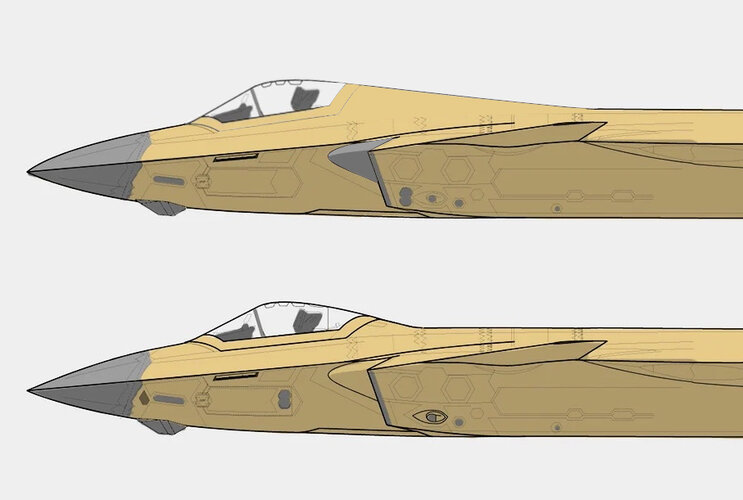
The whole canopy line seems to be at a different angle than on the J-20A. The rear part of the glazing is higher than the front part in relation to the sharp line that separates the lower and upper part of the fuselage.
The canopy has a reduced amount of transparency in the rear sector, which may have not reduced the field of view of the pilot (it might have not been possible to see that far in the back even on the previous version of the canopy).
The junction between the new canopy and the fuselage starts roughly around the canards height.
The radome has a beak now.
There might be something new in the exhausts as well, but since the available picture from the rear is so blurred I'm not sure about what's going on.
Further, there needs to be a distinction. The first pictures that appeared of 2051 show a softer junction between the fuselage and a different canopy. I'm inclined to think those pictures are fake, the reason being that the latest pictures of 2051 show an aircraft with the DSI bumps colored in grey, while the previous pictures show an aircraft with yellow colored DSI bumps.
FighterJock
ACCESS: Above Top Secret
- Joined
- 29 October 2007
- Messages
- 5,561
- Reaction score
- 5,863
There might be something new in the exhausts as well, but since the available picture from the rear is so blurred I'm not sure about what's going on.
It will be interesting to compare the different style of exhausts between the J-20A and the J-20C, considering that the C model uses two dimensional thrust vectoring nozzles.
- Joined
- 2 January 2006
- Messages
- 3,805
- Reaction score
- 4,952
There might be something new in the exhausts as well, but since the available picture from the rear is so blurred I'm not sure about what's going on.
It will be interesting to compare the different style of exhausts between the J-20A and the J-20C, considering that the C model uses two dimensional thrust vectoring nozzles.
IMO it won't ... for the moment - based on all accounts - it will use WS-10Cs too and later it will just regular 3D TVC-nozzles for the WS-15s.
djfawcett
With Enough Power, Anything Will Fly
- Joined
- 16 December 2012
- Messages
- 268
- Reaction score
- 388
I really don't disagree with what you have to say. After rereading what I wrote, I should have said the attitude of "good is good enough" allowed the folks to kick off production tooling, etc. When I was working with SAC on a general aviation project, I sat dumb founded when the management elected to kick off cutting metal and fabricating molds with most of the systems in their infancy. Our role was certification instruction. I had to laugh, this is just about the exact opposite you would want to do.Having had a look back over this program I'm not quite sure "good is good enough" is fully applicable. Just look at the amount of changes the J-20 underwent between the first prototype and current production aircraft. On the surface alone there must be hundreds. Some big, some small. They clearly spent a lot of time refining the aerodynamic as well as low observeable aspects. Canopy shape was one of the things that received refinement with prototype 2017s introduction compared to earlier serials. That shape has stayed as the current baseline. So already there was a small change to something they saw as an improvement.The bottom line is that the aft canopy modification was most probably an effort to mitigate the canopy shock (both J-35 and J-20), which in fact will or can create a noticeable drag count rise. How they discovered it is irrelevant (quite frankly a simple CFD analysis will pick it up). As far as, AVIC acting as a conduit the transfer of data between SAC and CAC, it just does not happen that way. I have worked with AVIC and SAC prior to all the craziness in the world, and the sublevels of the AVIC organization or very compartmentalized. I suppose that it is possible that the information may transfer that way, but it is not very probable. What I have seen in the Chinese organizations is an attitude of "good is good enough". They probably knew that had a drag rise there but it was good enough. Furthermore, historically, it is somewhat common for Chinese aerospace firms to make late program modifications, and this is one of them.
This latest change comes after years of flying the aircraft operationally which tells me, like other have also said here, that they learned that certain compromises made in the name of better visibility for example wasn't worth the trade-off under operational conditions. It points to J-20s operational docturine as much as it does to their aerodynamic proficiency. It also won't surprise me if this knowledge has been around for a couple years now (look at F-35 too as an example perhaps) but J-35 still being under full-scale development was just in a better position to incorporate the required changes earlier.
- Joined
- 29 November 2010
- Messages
- 1,771
- Reaction score
- 3,467
are there any current or planned 5/6 gen aircraft using 2D tvc nozzles other than the F-22/YF-23/X-2?
it seems everything will be using 3d TVC nozzles, or no TVC period (YF-23 pilot claimed that its systems of flaps and lifts nearly matched the performance of 2d TVC)
it seems everything will be using 3d TVC nozzles, or no TVC period (YF-23 pilot claimed that its systems of flaps and lifts nearly matched the performance of 2d TVC)
are there any current or planned 5/6 gen aircraft using 2D tvc nozzles other than the F-22/YF-23/X-2?
it seems everything will be using 3d TVC nozzles, or no TVC period (YF-23 pilot claimed that its systems of flaps and lifts nearly matched the performance of 2d TVC)
Hmm?
YF-23 didn't have TVC.
X-2 technically had 3D TVC.
And at this stage we don't know what other 5th generation fighters will have in terms of TVC, let alone 6th generation
Dreamfighter
'Senior Something'
- Joined
- 13 July 2008
- Messages
- 483
- Reaction score
- 642
are there any current or planned 5/6 gen aircraft using 2D tvc nozzles other than the F-22/YF-23/X-2?
it seems everything will be using 3d TVC nozzles, or no TVC period (YF-23 pilot claimed that its systems of flaps and lifts nearly matched the performance of 2d TVC)
Hmm?
YF-23 didn't have TVC.
X-2 technically had 3D TVC.
And at this stage we don't know what other 5th generation fighters will have in terms of TVC, let alone 6th generation
YF-23 is also not 'current' anymore, though it´s looks might suggest it still is.
Boeing´s X-32 is not current anymore either, but that one did have 2D TVC.
FighterJock
ACCESS: Above Top Secret
- Joined
- 29 October 2007
- Messages
- 5,561
- Reaction score
- 5,863
Slowly getting better ...

They are teasing us Deino.
- Joined
- 16 January 2015
- Messages
- 779
- Reaction score
- 3,454
Pretty sure that's a fake picture.
Several areas of the aircraft have been touched up, the shapes of the canopy and radome are inconsistent with what we can see from the pictures with the open canopy (which are definitely more credible).
At a glance, I would say somebody took a F-22 canopy and slapped it on a J-20, then repainted it in PS.
Several areas of the aircraft have been touched up, the shapes of the canopy and radome are inconsistent with what we can see from the pictures with the open canopy (which are definitely more credible).
At a glance, I would say somebody took a F-22 canopy and slapped it on a J-20, then repainted it in PS.
- Joined
- 2 January 2006
- Messages
- 3,805
- Reaction score
- 4,952
Oh no … come on! It surely has been modified but we know already more than a handful of different images all from different angles and so the aircraft is real regardless what you think and surely not a posed Raptor.Pretty sure that's a fake picture.
Several areas of the aircraft have been touched up, the shapes of the canopy and radome are inconsistent with what we can see from the pictures with the open canopy (which are definitely more credible).
At a glance, I would say somebody took a F-22 canopy and slapped it on a J-20, then repainted it in PS.
- Joined
- 29 November 2010
- Messages
- 1,771
- Reaction score
- 3,467
now that we got a clearer pic although a different angle
it does seem the drawings of the new spine is slightly off.
actual spine angle isnt as steep compared with the body
it does seem the drawings of the new spine is slightly off.
actual spine angle isnt as steep compared with the body
- Joined
- 2 January 2006
- Messages
- 3,805
- Reaction score
- 4,952
Two new images of the J-20B no. 2051 ... and these only give a rudimentary idea of which photos are still on the wallclimber's SD-cards but have not yet been posted.
(Images via @yanyan25/SDF)


(Images via @yanyan25/SDF)


- Joined
- 2 January 2006
- Messages
- 3,805
- Reaction score
- 4,952

This J-20A said to be the first one performing its maiden flight in 2023 shows IMO what some suggested already before: the final numbers are sequential and not "per batch".
Consequently I read this indeed as a Batch 07 but the 156th J-20A overall built and not the 156th J-20A within Batch 07. This again fits IMO now much better to a system that correlates to other estimations, namely that each batch has a size of 20 aircraft and not all brigades are actually operate a full complement.
A theory to the cn.s could therefore be (via Derpy/SDF):
00 1-20
01 21-40
02 41-60
03 61-80
04 81-100
05 101-120
06 121-140
07 141-160
(Image via @航空融媒 / WB)

Similar threads
-
Shenyang FC-31 demonstrators / J-35 naval fighter / J-35A land-based version
- Started by Foxglove
- Replies: 993
-
-
-
-

